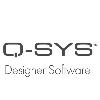New Windows 11 Pro support, with Audio and Video improvements
Improvements
Version 9.7.0 includes these new features, updates, and resolved issues.
Platform
Windows 11 Pro support
- Q-SYS Designer Software now supports installation on Windows 11 Pro hosts.
NM-T1 microphone support
- Q-SYS 9.7.0 introduces support for the NM-T1, which is available from the Inventory > Audio - Q-LAN category.
- The Q-SYS NM Series NM-T1 is a tabletop network PoE microphone native to Q-SYS and ideal for the collaboration space. The microphone features advanced beamforming technology that ensures optimal clarity and separation for all surrounding talkers. It also offers onboard call controls, programmable user button and touchless muting capability, which lets users mute or unmute with the wave of a hand. As a native Q-SYS product, the NM-T1 integrates seamlessly into your Q-SYS system without the need for complex programming.
Core 6000 CXR support
- The Q-SYS Core 6000 CXR processor is an industry-first solution that combines the processing capabilities of the Q-SYS realtime operating system with the compact, ruggedized, MIL-STD, NEBS and Marine compliant Dell PowerEdge XR11 server. Core 6000 CXR is the only IT-grade solution that brings audio, video, and control processing into marine applications.
Core Nano and Core 8 Flex: Peripheral Mode support
- As with the NV-32-H (Core Capable) and Core 510i, the Core Nano and Core 8 Flex now support the ability to run in Peripheral Mode. In this mode, you add the I/O-Core Nano or I/O-Core 8 Flex as an Inventory peripheral, and then configure a separate Q-SYS Core processor to run your design.
Network Redundancy: Stream usage
In Q-SYS 9.7, a redundant Q-LAN stream is counted as two streams for these Core models:
- NV-32-H (Core Capable in Core Mode)
- Core Nano
- Core 8 Flex
- Core 110f, Core 110c
- Core 510i, Core 510c
- Core 610
Discontinued: PTZ-IP Series cameras
- The PTZ-12x72 and PTZ-20x60 cameras are now discontinued. To add them to new designs, select the Show Discontinued option in the Inventory menu.
Audio
Media Stream Receiver: HTTPS support
- The Media Stream Receiver (MS-RX) component now supports secure HTTP (HTTPS) stream URLs. For example: https://<stream>/livestream/special_stream.m3u8</stream>
Generic Speaker: New limiter parameters
- The Generic Speaker component includes new properties for Peak Attack (ms) and Peak Release (ms), allowing for additional customization of limiter parameters for low impedance loudspeakers not manufactured by QSC.
Removed: "Maximum DSP" property
- The Maximum DSP property, applicable to the Core 510i and 510c processors through Q-SYS 9.6, has been removed. Starting with Q-SYS 9.7, designs always use "max DSP" for all Core models (the former default of "Yes").
Video
NC Series: PTZ camera imaging improvements / new default values
- As with the NC-110 ePTZ camera imaging improvements in version 9.6.0, imaging from NC Series PTZ cameras (NC-12x80 and NC-20x60) is now improved in version 9.7.0, with updated Camera Imaging tab default values in the camera's Status/Control component and connected USB Video Bridge components. After upgrading to version 9.7.0, the easiest way to take advantage of these improvements is to reset all the camera's settings:
- In the Camera Control tab, save your camera's Home and Privacy positions (coordinates), if desired, to apply after the reset. (These are cleared during the reset.)
- In the Camera Imaging tab, click Reset all Camera settings (Imaging, PTZ, and Focus).
Cameras: High-resolution graphic support for UCIs, Mediacast to HDMI, and USB Video Bridging
- Q-SYS UCI and Mediacast endpoints now support high resolution graphics for Privacy Image, Exiting Privacy Image, and Offline Image. And, the default images are now high resolution and have a fresh, new look. In most cases, re-uploading custom graphics will greatly improve quality.
NV Series: High resolution default graphics
- Q-SYS 9.7 introduces high resolution default graphics for Graphic 2, Graphic 3, and the Idle Screen.
NV Series: Support for 21:9 aspect ratio on HDMI inputs and outputs
- Q-SYS NV Series devices now include a 21x9 EDID file that provides support for up to 3440x1440p60 resolution from AV sources and to HDMI displays supporting 21x9 formats. The new 21x9 EDID file is selectable within the Generic AV Source component.
TSC-G3 Series: Q-SYS AV Bridging
- Q-SYS AV Bridging is a new licensed feature paradigm to the Q-SYS ecosystem. This new type of feature license allows flexibility in pricing and deployment by allowing Q-SYS to price the TSC-G3 competitively without the price of USB bridging baked in. If you don’t need bridging, you don’t need to pay for the license. If you do need bridging, you can pay for the license for each bridging device required
I/O-USB Bridge: Improved USB Video Bridging quality
- The I/O-USB Bridge now has improved image quality when bridging 1080p and 720p MJPEG formats.
Auto Privacy
- Mediacast routing can be quite flexible and provide complex routing for a variety of use cases. In 9.6, Auto Privacy was not possible if the upstream camera was wired to any Mediacast to HDMI endpoints. In 9.7.0, it is now possible to have fully functional Auto Privacy behavior regardless of the wired endpoint. For proper Auto Privacy functionality, you must enable Auto Privacy at every wired Mediacast endpoint.
Video Freeze
- Video Freeze is a new Control toggle offered in the Generic HDMI Display when connected to an HDMI I/O Decoder. This new feature allows you the ability to freeze your video on its current video frame without hindering the audio. When enabled, the HDMI output will constantly replay the current video frame regardless of its source. When disabled, the HDMI output will resume showing full frame rate video. A Control Pin has been added to the HDMI AV Input hierarchy called Video Freeze.
Control
Call Sync enhancements
- The Call Sync feature is no longer in Beta status and is now officially supported. In addition, Call Sync now supports connections from up to eight simultaneous Call Systems (including HID Conferencing, Softphone, and POTS Controller), and also integrates with the Q-SYS NM-T1 beamforming microphone as an Endpoint.
Asset Manager: Lua Modules
- Lua Modules are now an installable asset type in Asset Manager.
Asset Manager: Plugin "Certified" and "Ready" badges
In Asset Manager, badges now indicate if a plugin and the hardware/software that the plugin supports is Q-SYS Certified Technology or Q-SYS Ready Technology.
Q-SYS Certified Technology
The "Certified" badge indicates that a plugin:
- Was developed in collaboration with Q-SYS
- Offers an enhanced experience that has been certified and endorsed by the Q-SYS Technology Partner Program
- Is supported by both Q-SYS and the Partner
- May include integration with Q-SYS Reflect Enterprise Manager
Q-SYS Ready Technology
The "Ready" badge indicates that a plugin:
- Was developed independently by the Partner
- Offers an enhanced experience that has been verified to be interoperable by the Q-SYS Technology Partner Program
- Is supported by the Partner
Lua Scripting: Crypto.Cypher support for AES_256
- Crypto.Cypher now supports AES_256_CBC and AES_256_ECB as arguments, in addition to existing support for AES_128.
Lua Scripting: TcpSocketServer connection IP addresses
- TcpSocketServer now prints the IP address of a connected client in a new PeerAddress field.
Management
Enterprise Manager: Presets enhancements
The Presets feature is no longer in Beta status and is now officially supported. In addition:
- Presets now support configuration and System synchronization of SNMP and Network Services category settings.
- To safeguard against losing connectivity to a Q-SYS Core processor due to improper Preset settings, Enterprise Manager backs up the current settings for each Preset category and then checks for proper connectivity to the Core before applying new settings. If this connectivity check fails, the Preset settings are reverted.
Enterprise Manager: Design Backup (Beta)
- To provide peace of mind in situations when reverting a Q-SYS Core processor to a previous state is necessary, any Q-SYS Core processor registered with Reflect now backs up its running design to Reflect. With a Professional Tier subscription, a backup can then be exported and re-deployed to a Core when needed.
Core Manager: Cameras > Firmware Update page removed
- The Video > Cameras > Firmware Update page no longer appears in Core Manager, as PTZ-IP Series cameras are discontinued and will receive no further firmware updates.
Bug fixes
- Audio: Grandmaster mismatch errors no longer occur when connecting QIO inputs.
- Audio: An issue that could cause "Packet Missing Streaming Errors" from QIO audio devices on networks with heavy traffic has been resolved.
- Platform: The Collaboration Bundle license is no longer inadvertently shown as being required with certain designs using External USB Audio and AEC.
- Platform: An issue that could cause PA Router Core-to-Core paging connections to drop momentarily has been resolved.
- Platform: An issue that could cause UCIs to not be discoverable in the Q-SYS Control iOS app when a Core's LAN A and LAN B interfaces are both connected to networks has been resolved in Q-SYS 9.7 with app version 3.6 and later.
- Platform: An issue that could cause Control Compute CPU usage to go to 100% with four or more Media Stream Receiver components in the design has been resolved.
- Loudspeakers: The unusable Status control pin for NL Series Loudspeaker Output components has been removed.
- Loudspeakers: Limiter settings have been corrected for some older Q-SYS loudspeaker models in 70V/100V mode.
- Video: CEC On/Off commands and the Display Power Status LED now function properly in conjunction with heavy Shift AV processing on NV-32-H (Core Capable) devices.
- Video: It is no longer possible to inadvertently control a PTZ-12x72 or PTZ-20x60 camera from two different designs.
- Video: The Status component for NV-32-H Encoders now properly indicates the Mediacast input Source Name.
- Video: An issue that could cause USB Video Bridges to show as disconnected and stop bridging video after a period of time has been resolved.
- Video: The default imaging settings for NC Series cameras have been optimized for conference room applications with average color temperature (4000K).
- Video: An issue that could cause USB bridged audio and video from an NV-32-H Encoder to a Mac to eventually stop has been resolved.
- Control: Blocks no longer disappear after editing and saving them in Block Controller or upgrading a design.
- Control: It is now possible to update the Script Access property for multiple components simultaneously without error.
- Control: MTR now works properly if a network proxy service is configured (and the proxy service has been configured to allow proxy bypass).
- Control: HID Keyboard component functionality has been restored when using Q-SYS Core processors and peripherals with Google Meet hardware.
- Control: Control names for QIO peripheral input and output components now properly start at 1 instead of 0, in parity with other component control names.
- Control: SNMP requests in scripts no longer cause increasing memory usage and eventual Core unresponsiveness.
- Control: TSC-G2 Series touch screens now properly auto-negotiate to 100 Mbps regardless of the connected network switch model, resulting in a stable connection.
- Control: Settings for port speed, data bits, and parity are now sent to QIO-S4 devices from Block Controller and Command Buttons components when a design starts running or after a device reboot.
- Control: Frequent camera switching in Mediacast Router no longer results in UCI Viewer or Q-SYS Control for MTR app instability when connected to a Core via LAN B or AUX LAN.
- Streaming I/O: In a Core-redundant configuration, System Link AV and audio streams now resume as expected after forcing a Primary Core back to Active status.
- Management: It is once again possible to bulk-select files in Core Manager > Files. Use Shift + Click to select a range of files or Ctrl + Click to select multiple individual files.
- Management: Core Manager now displays an error when trying to configure an invalid subnet mask (Netmask) for a LAN adapter.
- Management: The America/Cancun time zone selection in Core Manager no longer inadvertently adjusts for DST.


